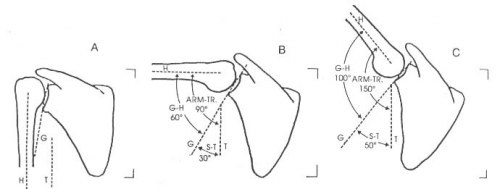There is no denying the value of the bench press as a powerful method of strength development. Similarly, there is no denying the potential for musculo-skeletal damage that can result from poor mechanics. Here, we explore the mechanics of this movement, particularly in relation to its effect on the shoulder girdle. The shoulder is a complex joint with multiple articulations (between the spine, scapulae and humerus). To understand the effects of bench press (or any other movement) on the shoulder girdle, we must first be familiar with the concept of scapulo-humeral rhythm. 

Basically, the above image shows four stages of shoulder movement:
- An initial movement of the gleno-humeral joint (where the shoulder blade joins the humerus).
- A movement of both the gleno-humeral and the scapulo-thoracic joint (where the shoulder blade joins the spine).
- A secondary movementof the gleno-humeral joint.
- A final movement of the scapulo-thoracic joint.
Although this diagram show S-H rhythm for abduction of the arm, the importance is mirrored in shoulder extension and horizontal abduction (as seen in the bench press). The correct order of movement allows for a healthy joint, and maximum force generation. The key point here is that there must be a degree of scapula movement during any movement with shoulder girdle involvement. Let’s delve a bit deeper in to the anatomy and physiology of the shoulder joint.
Since we’re concerned with movement, exploring the multiple movements at the shoulder can give us some clues as to technique modification for healthy joint mechanics. Specific to the bench press, we SHOULD experience extension and horizontal abduction at the gleno-humeral joint (where the arm meets the scapula), and retraction of the scapula. Here-in lies the crux of the matter. RETRACTION OF THE SCAPULA IS VITAL.
We came up with a method of demonstrating the difference in bench pressing position with a pre- movement retraction of the scapula versus position with no pre- movement retraction. We used a black texta to trace over the scapulae on our model and then photographed the completion of the movement through a glass surface. Examine the images below, ‘spot the difference’, give them some consideration, then we’ll discuss. 
 Image one matches the starting position of the bench press following unracking the weight. At this point, there’s nothing wrong with the scapula position. In image two however, the scapulae have been WEDGED APART by the bench (or in this case, the glass). Due to the restrictions of the glass, this movement is more comparable to a floor press than a bench press – the effect would be even more pronounced with the full range.
Image one matches the starting position of the bench press following unracking the weight. At this point, there’s nothing wrong with the scapula position. In image two however, the scapulae have been WEDGED APART by the bench (or in this case, the glass). Due to the restrictions of the glass, this movement is more comparable to a floor press than a bench press – the effect would be even more pronounced with the full range.
The humerus has gone through the required extension and horizontal abduction at the gleno-humeral joint, but the scapula have not been allowed to retract. The entire load is being placed on the capsular ligament of the shoulder as the humerus goes into hyper-horizontal abduction. Long term, this causes a reactive tightening of the muscles involved in internal rotation of the humerus. Couple this with a weakening of the external rotators and you get the postural (and associated biomechanical) abnormalities so often seen in bench press disciples.  Contrast this to the third and fourth images. In these, the scapulae have been retracted prior to the decent of the bar. At the end of range, the scapulae remain retracted, allowing clear passage of the humerus through safe range in horizontal abduction. If injury eradication isn’t enough of a motivator, consider the effects of scapula retraction on strength capacity:
Contrast this to the third and fourth images. In these, the scapulae have been retracted prior to the decent of the bar. At the end of range, the scapulae remain retracted, allowing clear passage of the humerus through safe range in horizontal abduction. If injury eradication isn’t enough of a motivator, consider the effects of scapula retraction on strength capacity:
- Wth retracted scapulae, you are effectively shortening the distance the load must be moved.
- By keeping the scapulae in contact with the bench, you are creating an artificial stability – and thus a more stable based from which to generate force.
Lock those shoulderblades back. It will build greater strength and stability, will keep your shoulder girdle healthy, will create a greater balance of musculature about the shoulder and will make you bench more.




